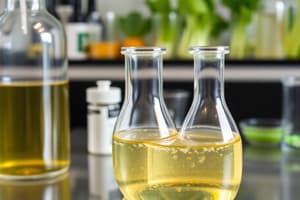Podcast
Questions and Answers
What is the primary difference between aerobic fermentation and anaerobic fermentation?
What is the primary difference between aerobic fermentation and anaerobic fermentation?
- Aerobic fermentation is faster than anaerobic fermentation.
- Aerobic fermentation occurs in yeasts, while anaerobic fermentation occurs in bacteria.
- Aerobic fermentation requires the presence of oxygen, while anaerobic fermentation occurs in the absence of oxygen. (correct)
- Aerobic fermentation produces more energy than anaerobic fermentation.
Which term is commonly used to describe the phenomenon of aerobic fermentation in yeast?
Which term is commonly used to describe the phenomenon of aerobic fermentation in yeast?
- Lactic acid production
- Glycolysis
- Crabtree effect (correct)
- Alcoholic fermentation
Why does yeast require oxygen for certain processes essential for reproduction?
Why does yeast require oxygen for certain processes essential for reproduction?
- To enhance the flavor of the final product.
- To establish a strong yeast colony. (correct)
- To prevent the growth of bacteria.
- To produce more alcohol during fermentation.
In which type of fermentation is oxygen not available in the surrounding environment?
In which type of fermentation is oxygen not available in the surrounding environment?
Why do some types of fermentation processes require oxygen initially?
Why do some types of fermentation processes require oxygen initially?
What is the incorrect statement about aerobic fermentation based on the text?
What is the incorrect statement about aerobic fermentation based on the text?
What is the byproduct produced during fermentation process under anaerobic conditions?
What is the byproduct produced during fermentation process under anaerobic conditions?
Which type of fermentation results in the production of ethanol and carbon dioxide?
Which type of fermentation results in the production of ethanol and carbon dioxide?
Which type of lactic acid fermentation does not release gas as a byproduct?
Which type of lactic acid fermentation does not release gas as a byproduct?
Which organisms are responsible for transforming sugars into lactic acid during lactic acid fermentations?
Which organisms are responsible for transforming sugars into lactic acid during lactic acid fermentations?
What is the most important compound resulting from lactic acid fermentation?
What is the most important compound resulting from lactic acid fermentation?
Which of the following is an example of an ancient lactic acid fermented food?
Which of the following is an example of an ancient lactic acid fermented food?
Which process uses oxygen to produce ATP?
Which process uses oxygen to produce ATP?
What is the primary function of anaerobic fermentation?
What is the primary function of anaerobic fermentation?
What is the key difference between anaerobic and aerobic respiration?
What is the key difference between anaerobic and aerobic respiration?
In anaerobic fermentation, what process restores NAD+ for glycolysis?
In anaerobic fermentation, what process restores NAD+ for glycolysis?
What type of phosphorylation is associated with substrate-level phosphorylation?
What type of phosphorylation is associated with substrate-level phosphorylation?
Which enzyme catalyzes the conversion of pyruvate to acetaldehyde in ethanol fermentation?
Which enzyme catalyzes the conversion of pyruvate to acetaldehyde in ethanol fermentation?
Flashcards are hidden until you start studying




